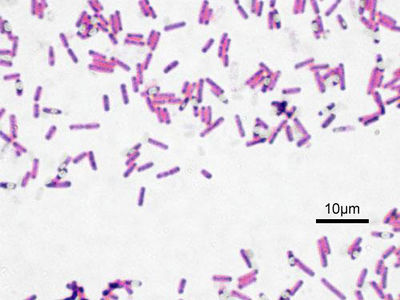Polyhydroxyalkanoates: Difference between revisions
(+video) |
mNo edit summary |
||
| Line 1: | Line 1: | ||
[[File:Bacillus subtilis Gram.jpg| | [[File:Bacillus subtilis Gram.jpg|400px|thumb|right|Certain strains of [https://en.wikipedia.org/wiki/Bacillus_subtilis Bacillus subtilis] bacteria can be used to produce polyhydroxyalkanoates.]] | ||
[https://en.wikipedia.org/wiki/Polyhydroxyalkanoates Polyhydroxyalkanoates] are linear polyesters produced naturally by bacterial fermentation of sugar or lipids. More than 150 different monomers can be combined within this family to give materials with extremely different properties. These plastics are biodegradeable and are used in the production of bioplastics. Polyhydroxyalkanoate polymers are thermoplastic, can be processed on conventional processing equipment, and are, depending on their composition, ductile and more or less elastic. | [https://en.wikipedia.org/wiki/Polyhydroxyalkanoates '''Polyhydroxyalkanoates'''] are linear polyesters produced naturally by bacterial fermentation of sugar or lipids. More than 150 different monomers can be combined within this family to give materials with extremely different properties. These plastics are biodegradeable and are used in the production of bioplastics. Polyhydroxyalkanoate polymers are thermoplastic, can be processed on conventional processing equipment, and are, depending on their composition, ductile and more or less elastic. | ||
'''Carbon Sources:''' Carbohydrates (molasses, sucrose, starch, lactose from whey, [[cellulose]] hydrolysates), alcohols ([[glycerol]], [[methanol]]), fats and oils, organic acids. | |||
Applications: packaging and coatings, hygienic articles, fibers, adhesives, carriers of flavoring substances in foods, biodegradable fishing nets, etc. Also various medical applications (e.g. implant materials, suture materials, controlled release of active principles). | '''Applications:''' packaging and coatings, hygienic articles, fibers, adhesives, carriers of flavoring substances in foods, biodegradable fishing nets, etc. Also various medical applications (e.g. implant materials, suture materials, controlled release of active principles). | ||
==Related Pages On This Wiki== | ==Related Pages On This Wiki== | ||
Revision as of 18:36, 21 August 2016

Polyhydroxyalkanoates are linear polyesters produced naturally by bacterial fermentation of sugar or lipids. More than 150 different monomers can be combined within this family to give materials with extremely different properties. These plastics are biodegradeable and are used in the production of bioplastics. Polyhydroxyalkanoate polymers are thermoplastic, can be processed on conventional processing equipment, and are, depending on their composition, ductile and more or less elastic.
Carbon Sources: Carbohydrates (molasses, sucrose, starch, lactose from whey, cellulose hydrolysates), alcohols (glycerol, methanol), fats and oils, organic acids.
Applications: packaging and coatings, hygienic articles, fibers, adhesives, carriers of flavoring substances in foods, biodegradable fishing nets, etc. Also various medical applications (e.g. implant materials, suture materials, controlled release of active principles).
Related Pages On This Wiki